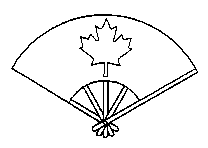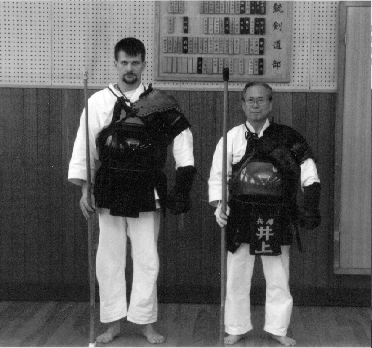Journal of Japanese Sword Arts
A monthly magazine dealing with all aspects of Japanese sword study.
Subscribing to the Journal of Japanese Sword Arts
Issue: #90 Apr. 1998
|

Journal of
Japanese Sword
Arts
A monthly journal concerning all aspects of
the use of the Japanese Sword. Articles,
news, reviews, technical tips.
$36 cdn in Canada per year $36 US in USA
$48 overseas.
JJSA Kim Taylor, ed. 44 Inkerman St.
Guelph, Ontario, Canada, N1H 3C5 |

ABOUT TOYAMA RYU IAI AND SUNDRY
Inoue soke, (r) and Mr. Raul Hirvonen (l) from Finland after jukendo training at Nishinomiya
dojo, Osaka.
An interview of Inoue Soke in Helsinki on June 15, 1997 by Pasi Hellstén (interpreted by Mr.
Yuji Matsuoi). Translation into English: Ms. Leena Mäkinen.
Inoue Tsuyoshi Munetoshi, Soke of Hontai Yoshin ryu jujutsu, instructed a seminar in June 1997
in the Helsinki Sports Hall. Hontai Yoshin ryu iaijutsu was included in the curriculum. As we
knew that he had also taught Toyama ryu iai, which is a more modern iaijutsu art, we requested
an interview on the subject. This interview was made during the closing party of the seminar.
Is it so that Soke is nowadays teaching only Hontai Yoshin ryu iaijutsu and not Toyama ryu
iaido?
Soke is still teaching both arts.
Can we ask a few questions about Toyama ryu? We are under the impression that Nakayama
Hakudo Sensei was one of the founders of Toyama ryu iai. Is it true?
Nakayama Hakudo Sensei was an instructor for the Japanese army, air forces and navy. In the
Showa era he was the kenjutsu shihan or head instructor for these forces. One of the places
where he taught was Toyama Gakko in Tokyo. Nakayama Hakudo Sensei's own background was
in Eishin ryu and on that basis he attempted to teach and work out techniques suited for the
armed forces.
Are there similarities in Toyama ryu and the Mugai ryu we just had an opportunity to learn?
It is true that there are similar techniques in various styles, but the Toyama ryu techniques
originate with Nakayama Hakudo Sensei.
What was the role of Nakamura Taisaburo of Toyama ryu?
Nakayama Hakudo Sensei created Toyama ryu iai. During and after the war there were some
kendo students who were Nakayama Hakudo Sensei's pupils, and they wanted to preserve his
Toyama ryu. They came together after the war and started to train again. At that time colonel
Morinaga was instructing at Toyama Gakko, and his superior was Usawa Kyuzo, a
major-general. Another subordinate of Usawa Sensei was Yamaguchi Yuuki, who was of a
lower rank than Colonel Morinaga, but had first-class sword technique. It was at that time that
Nakamura came to study at the school.
Nakamura Sensei is no longer active in Toyama ryu, but has his own school, Nakamura ryu?
That is correct. Morinaga Sensei, Yamaguchi Sensei and Nakamura Sensei met in Kyoto in
Showa 51 (1976) for the first Zen Koku Taikai. These three persons were planning to unite the
three Toyama ryu styles. After the Taikai there was a closing party, where Nakamura Taisaburo
Sensei distributed cards naming him the Toyama ryu Soshihan or head instructor. Morinaga and
Yamaguchi senseis remarked that they had not discussed granting the rank of soshihan to
Nakamura Taisaburo. They were after all his teachers! The Head of Toyama ryu?
As there was no unification, there still are three branches, Yamaguchi-ha, Morinaga-ha and
Nakamura-ha. There is no common leader.
When did Soke become active in Toyama ryu?
In Showa 51 he and Sato Sensei participated in a demonstration, but two or three years before
that Kobayashi Sensei from Himeji had asked Inoue Sensei to come and help them out with the
Toyama ryu. In Nishinomiya as well as the Hyogo and Himeji prefectures Toyama ryu was in a
bad shape, and Inoue Sensei's presence was bound to improve things. This is why he decided to
go along.
Soke has apparently also practiced jukendo?
Soke has a 8th dan in jukendo, and this was one of the reasons why Kobayashi Sensei wanted
Soke to join Toyama ryu iai.
Did Soke's knowledge of jukendo originate in the army?
Soke was not in the army before the war, but in those days all citizens over 13 years had to know
jukendo. That is where his knowledge of the art comes from.
Is Toyama Gakko in Tokyo?
Not any more. Soke does not remember where in Tokyo the building was situated. Toyama
Gakko was an army school, but in addition to budo there was also an army music school in the
premises. In fact, Toyama Gakko used to be famous as the Army Music School, the budo
activities were kept somewhat secret.
Was Toyama Gakko open for both officers and non-commissioned officers?
Not especially for officers or non- commissioned officers. Also privates who had distinguished
themselves could be called to attend.
Who grants the grades in Toyama ryu?
The grades in use are dan grades and renshi, kyoshi and hanshi instructor grades. Nowadays, and
also before, of course, all the three styles see to their own grades. The grades begin from 1st dan
and renshi can be obtained after 5th dan. After the 5th dan one has to train for about ten years
before one can get a kyoshi.
Toyama ryu is then still taught in various parts of Japan?
The three schools have a bit differing technique, though they are of course close to each other.
Inoue Soke is practicing under Yamaguchi Yuuki Sensei, and Yamaguchi-ha is the biggest of the
schools. During the army period Yamaguchi Sensei taught iai all the time, and his technique is
superb. He is now 97 years old and still teaches. He lives in Sapporo on Hokkaido. Every year
Sensei comes to Kyushu driving his own car. For many years he has said that this may be his last
trip, but always he has come again. He was bout 180 cm tall when he was young, but now he is
somewhat shorter. But his shoulders are still like those of Soke and Sato Sensei together and his
arms are thick as the thighs of other people. In the early days he used to teach kendo and jukendo
in Kanto-kun in Manchuria.
Is tameshigiri important in Toyama ryu? Is it practiced a lot?
There is tameshigiri practice once a month at our Honbu dojo, in Nishinomiya, but it is not of
prime importance. There are many other things which one has to practice. Still, tameshigiri is
necessary at times for understanding of hasuji (the right path of the blade).
Is the sword used in Toyama ryu a short one?
It does not matter, a long one will do. During the army times the length was set at 2 shaku 1 sun.
It can be measured thus: if you let your arm hang naturally down your side gripping a sword
lightly and then swing it back and forth, the kensaki (tip of the sword) must not touch the
ground. In the army all long swords were shortened to the same length with a machine. There
were so many swords it was not possible to do this by hand.
How does Soke see the differences between Toyama ryu and Hontai Yoshin ryu iai?
Toyama ryu is meant for real situations and does not include suwariwaza techniques. Soke has
himself trained Eishin ryu, Mugai ryu and Toyama ryu.
Soke wants to start kenjutsu again because bugei ju happan (the traditional Samurai fighting
arts) are a part of his Hontai Yoshin ryu style. In Sekiguchi ryu, among others, there is
nowadays more kenjutsu even though the jujutsu in that school used to be first-rate.
Soke is reviving iaijutsu. Was it so that the previous soke did not teach much iaijutsu?
Yes, it was so. The previous Soke, Minaki Saburo did not teach much iaijutsu. Perhaps he
thought jujutsu was best and taught it. In the Samurai times the previous soke would surely have
taught more about the use of a sword.
Still, did Minaki Soke practice iaijutsu himself?
Yes, he did. Soke's sword is his sword.
Are the teaching scrolls still in use?
Yes, they have been passed down. They include ken (sword arts), kodachi (short sword), jujutsu,
bojutsu, teppo (firearms) and sojutsu (spear fighting). But not all of these arts are nowadays
included in the curriculum.
What is the place of iaijutsu, when one teaches other things, such as jujutsu, bojutsu etc.?
It is very important. If one cannot use a sword, one cannot know bujutsu. In Hontai Yoshin ryu a
beginner should begin with iai. It is all the same whether one starts with Sato Sensei's Mugai ryu
or Hontai Yoshin ryu iaijutsu, anything will do. It is better to start with a sword, for if one has
not practiced iai, it is difficult to understand the sword side in jujutsu and bojutsu. In the times of
the Samurai almost all holders of menkyo kaiden in jujutsu had a menkyo kaiden in kenjutsu or
iaijutsu, too.
Are there many Hontai Yoshin ryu dojos?
Not so many. There is Honbu Dojo at Nishinomiya, other dojos in Himeji and a few places on
Kyushu.
Also the ninjutsu teacher Hatsumi says that they are using Hontai Takagi Yoshin ryu jujutsu, but
that is somewhat unclear. All our other dojos are to the south of Honbu Dojo. There are no dojos
in the Kanto area.
How do you go about gradings in Hontai Yoshin ryu?
Usually the arts are not graded separately: there is only one grade for all of them. In Japan not all
wish to train in all the arts included in Hontai Yoshin ryu. Sometimes it is possible to give
people dan grades just in the arts they train, but usually you have to master all of them. In the
"partial" arts you cannot get a menkyo grade, which are:
2nd dan shoden menkyo
4th dan chuden menkyo
6th dan okuden menkyo
7th dan menkyo kaiden
Soke said earlier that there has also been sojutsu?
Bojutsu come originally from Tendo ryu naginatajutsu. Kukishin ryu bojutsu was much
influenced by the Tendo ryu naginatajutsu and gave later birth to Hontai Yoshin ryu bojutsu.
Tankendo?
A tankendo is a kind of half-sword or wakizashi. It originates in army use. In the artillery,
soldiers had rifles only exceptionally. They did, however, always carry a short sword. Also
scouts used the same kind of weapons. Nowadays takendo matches are like kendo matches: the
armor and rules are like those of kendo.
In the times of the last shogun samurai and ordinary citizens formed one army. The ordinary
people had not practiced with a sword, which is why tankendo was taught. In the 10th year of
Meiji (1877) some Japanese went to France to learn about their army. Some techniques were
loaned from there, but adapted to the Japanese fighting style. The head instructor of Fuden ryu
sojutsu, Tsuda Venzo (?) Sensei, was also a jukendo teacher and can be regarded as a developer
of jukendo.
Many thanks to Soke for an interesting interview.

